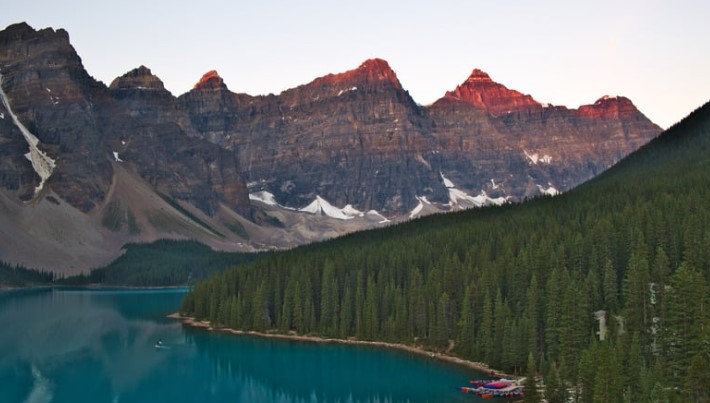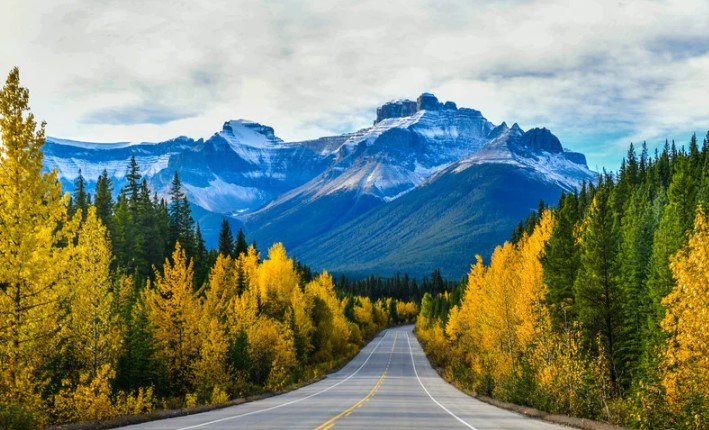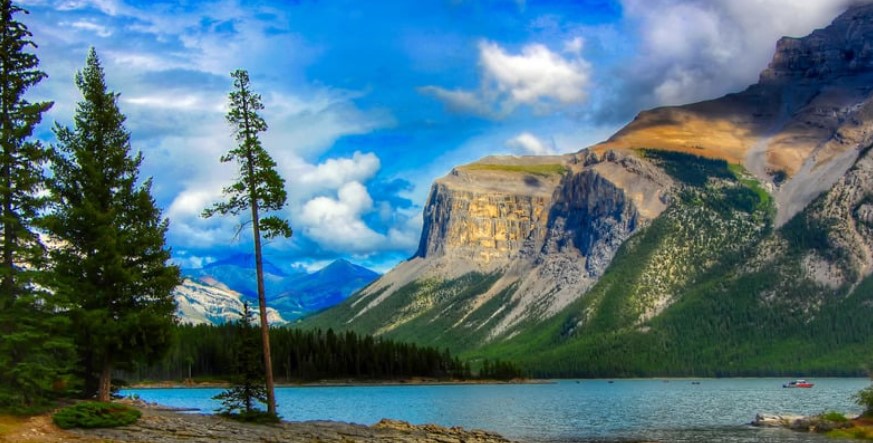Exploring the Best National Parks in Canada: A Journey Through Nature's Splendors

Canada is a land filled with breathtaking natural wonders. From the shimmering turquoise lakes in the west to the sandy beaches in the east, and from the northern lights dancing in the Arctic skies to the dense pine forests in the south, the country’s landscape is as varied as it is vast.
Have you ever heard of National Parks? These are unique places set aside by countries to protect nature’s beauty and the animals that live there. In Canada, they play a significant role. Parks like Banff National Park, Jasper National Park, and Yoho National Park are some of the gems where you can see Canada’s beauty up close.
These parks ensure that places like Lake Louise, Emerald Lake, and magical spots like Takakkaw Falls stay safe and sound for generations to enjoy.
National parks aren’t just about pretty views, though. They are crucial in keeping Canada’s natural heritage alive and well. When we talk about heritage, we mean everything from the black bears and polar bears that wander in the forests and icy lands to the ancient boreal forests and the stories of the land that go back thousands of years.
So, whether you’re planning a family road trip, an outdoor adventure, or just daydreaming about the most incredible places in Canada, our guide will take you coast to coast through the best National Parks in Canada. Prepare for amazing outdoor adventures and learn about Canada’s most stunning natural wonders.
1. Banff National Park, Alberta: A Treasure of the Rockies
Nestled in the heart of Alberta, Banff National Park is a must-visit spot when you’re thinking about the best national parks in Canada. Do you know it’s Canada’s oldest national park? That’s right! Established way back in 1885, Banff has a rich history. It started when three railway workers stumbled upon a cave containing hot springs on the slopes of the Rocky Mountains. Seeing the potential for a tourist spot, the area was set aside, and thus Banff National Park was born.
Key Attractions:
- Lake Louise: Imagine a big, beautiful body of water that looks like someone has dropped blue paint. That’s Lake Louise for you! With its turquoise waters, surrounded by tall mountains, it’s a sight you won’t forget.
- Moraine Lake: Just a little drive from Lake Louise, Moraine Lake is another blue wonder. The view of the lake with the Valley of the Ten Peaks behind it is something straight out of a postcard.
- Sulphur Mountain: Want a bird’s eye view of the park? Climb (or take a cable car) to the top of Sulphur Mountain. You’ll feel on top of the world!
Wildlife and Biodiversity: Banff is about more than just about pretty views. It’s a home. Black bears, grizzly bears, and even the elusive arctic foxes can be spotted if you’re lucky. And let’s remember the diverse plants and trees that make up the lush forest of this park. It’s a paradise for wildlife lovers!
Activities:
- Hiking: With miles of trails, from easy walks to challenging treks, there’s a path for everyone. The smell of pine forest and the chance of wildlife spotting make it an adventure of a lifetime.
- Skiing: Come winter, Banff turns into a snowy wonderland. If you love sliding down snow-covered slopes, this is your place!
- Hot Springs: Remember the story of the railway workers? Well, you can still visit those hot springs. After a long day of hiking or skiing, dip into the warm waters of the Radium Hot Springs and relax.
So, when planning your Canadian road trips, make sure Banff National Park is on your list. It’s not just a park; it’s an experience!
2. Jasper National Park, Alberta: A Wilderness Wonder
Just a bit north of Banff, you’ll find another gem, Jasper National Park. Nestled in the same province of Alberta, this national park is vast, wild, and filled with nature’s wonders. Established in 1907, it has been a beacon for explorers and nature lovers for over a century.
Location and Brief History: Jasper National Park is a part of the Canadian Rockies, making it a sibling to Banff. Its history is intertwined with the railway, just like Banff. The park was named after Jasper Hawes, who operated a trading post in the area long ago. Over the years, the park expanded, becoming the vast wilderness we know and love today.
Key Attractions:
- Maligne Lake: A lake so long that you can’t see its end and so blue that you might think it’s a piece of the sky. In its center lies the famous Spirit Island, a tiny land surrounded by towering mountains. It’s a spot that looks like a dream!
- Athabasca Glacier: Want to touch and feel an actual glacier? The Athabasca Glacier offers you just that. This ancient body of ice is awe-inspiring and reminds us of the icy age that once covered the entire country.
- Spirit Island: Though small, this island on Maligne Lake is a powerhouse of beauty. Often considered one of the most photographed spots in Canada, it’s a testament to nature’s ability to leave us speechless.
Wildlife: The wilderness of Jasper is bustling with life. Majestic elks stride across meadows while black bears search for berries. Looking up at the rocky outcrops, you might spot mountain goats and expert climbers showing off their skills.
Activities:
- Hiking: Jasper, with its varied landscape, offers endless hiking opportunities. From coastal trails to the heart of dense forests, each hike is a story waiting to be explored.
- Rafting: For those who love a thrill, the rivers of Jasper offer exciting rafting adventures. Feel the rush as you navigate the waters, surrounded by nature’s grandeur.
- Stargazing: Here’s a secret: Jasper is a dark-sky preserve. This means there’s minimal light pollution. On a clear night, you can lay back and watch the stars, maybe even catch a glimpse of the northern lights!
Jasper National Park is more than just a visit; it’s an immersion into the heart of Canada’s natural wonders. Whether you’re gazing at stars, hiking the trails, or just taking in the view, it’s an experience you will remember.
3. Pacific Rim National Park Reserve, British Columbia: A Coastal Haven
On the west coast of Canada, in the beautiful province of British Columbia, lies the Pacific Rim National Park Reserve. With the roaring Pacific Ocean on one side and lush forests on the other, it’s where land meets the sea most magically.
Location and Brief History: This park reserve was established in the early 1970s on Vancouver Island’s western shore. The idea was to protect the unique coastal ecosystems that thrived here, and over the years, it’s become a sanctuary for marine life, coastal forests, and countless visitors.
Key Attractions:
- Long Beach: This isn’t just any beach. Stretching for miles, Long Beach offers soft sand, crashing waves, and some of the best sunsets you’ll ever see. Perfect for a day of relaxation or adventure!
- Broken Group Islands: A cluster of more than 100 small islands and islets, this is a paradise for kayakers and those looking to explore untouched coastal scenery.
- West Coast Trail: For experienced hikers, this 75-kilometer trail promises the adventure of a lifetime. It winds through forests, beaches, and cliffs, showcasing the park’s natural wonders at every turn.
Marine Life and Coastal Ecosystems: This park reserve is a treasure trove of marine life. From starfish to seals and even the occasional humpback whale, the ocean is teeming with life. The coastal forests, with their towering trees and mossy grounds, are just as alive, providing a green contrast to the blue ocean.
Activities:
- Surfing: The waves here are perfect, and whether you’re a beginner or a pro, riding them is a joy.
- Kayaking: Paddle through the calm waters around the Broken Group Islands and discover hidden coves and marine life.
- Beachcombing: Walk along the shores, and you’ll find a world of wonders – from unique shells to age-old driftwood.
4. Gros Morne National Park, Newfoundland and Labrador: Nature’s Masterpiece
Shifting to the eastern side of Canada, Gros Morne National Park in Newfoundland and Labrador is like stepping into a natural art gallery.
Location and Brief History: This park was established in the 1970s on Newfoundland’s west coast. However, its history goes way back, with the land telling tales spanning hundreds of years!
Key Attractions:
- Western Brook Pond: This isn’t just a pond – it’s a massive freshwater fjord surrounded by towering cliffs. It’s a place that makes you realize the grand scale of nature.
- Tablelands: Imagine a place where the Earth’s mantle is exposed! The Tablelands, with its reddish-brown rocks, offers just that. It’s like walking on a different planet.
- Gros Morne Mountain: The park’s namesake, this mountain offers a challenging hike but rewards with views that are worth every step.
Geological Significance and UNESCO World Heritage Status: Gros Morne is a geological wonder. The park showcases the ancient forces that shaped our planet, from plate tectonics to glacial action. Recognizing its significance, UNESCO designated it a World Heritage site in 1987, marking it as a place of global importance.
Activities:
- Hiking: With miles of hiking trails, there’s a journey for everyone, from coastal trails to mountainous treks.
- Boat Tours: Sail on the Western Brook Pond and witness the majesty of the fjord up close.
- Cultural Experiences: This isn’t just a place of natural beauty. The local communities offer rich cultural experiences, from music to storytelling, capturing the heart and soul of Newfoundland.
Both Pacific Rim and Gros Morne showcase the beauty and diversity of Canada’s natural wonders. Each offers unique experiences waiting to be explored and cherished.
5. Auyuittuq National Park, Nunavut: A Glimpse into the Arctic
Deep in the north, where the world seems to touch the sky, lies Auyuittuq National Park in Nunavut. It’s a place where the horizon glows, and the landscapes seem otherworldly.
Location and Brief History: Situated on Baffin Island, Auyuittuq was designated a national park in 2001. “Auyuittuq” means ‘the land that never melts’ in Inuktitut, a nod to its icy landscapes.
Key Attractions:
- Mount Thor: Not only is it striking, but Mount Thor also boasts the world’s tallest vertical drop! It’s a sight that will leave you in awe.
- Akshayuk Pass: This ancient pass offers a journey through the park’s varied landscapes. From glaciers to valleys, every step tells a tale.
Unique Arctic Landscapes and Wildlife: Auyuittuq showcases the Arctic in all its beauty. It’s a land of ice caps, polar landscapes, and rare wildlife. You might spot the cunning arctic fox or a narwhal in nearby waters. But it’s not just about the animals; the land here, with its frosty demeanor, is alive in its own right.
Activities:
- Trekking: For those seeking adventure, the park offers treks that range from the serene to the challenging.
- Witnessing the Midnight Sun: Ever wanted to see the sun at midnight? The Arctic summer offers this magical experience, where day and night blur into one.
6. Riding Mountain National Park, Manitoba: Canada’s Heartland Beauty
Manitoba might be known as flat, but Riding Mountain National Park defies that notion. Rolling hills, deep forests, and shimmering lakes define this heartland gem.
Location and Brief History: Located in southwestern Manitoba, Riding Mountain National Park was established in the 1930s. It’s a testament to Canada’s commitment to preserving diverse ecosystems.
Key Attractions:
- Clear Lake: True to its name, it offers crystal-clear waters reflecting the surrounding forests and skies. It’s a place of tranquility and reflection.
- Bison Enclosure: Want to travel back in time? The Bison Enclosure allows visitors to see these majestic creatures up close, just as they roamed the prairies centuries ago.
Diverse Ecosystems: Riding Mountain is a melting pot of ecosystems. It’s a land of variety, from the grassy prairies to lush boreal forests and wetlands. This mix means that the park is teeming with wildlife. Deer, black bears, and even the elusive lynx call it home.
Activities:
- Camping: Whether in a tent or an RV, camping in the park is an experience. Night skies, morning mists, and the call of the wild make it unforgettable.
- Wildlife Viewing: With such diverse residents, the park is a haven for wildlife enthusiasts.
- Hiking: With miles of trails, there’s a hike for every age and skill level.
From the icy frontiers of Nunavut to the varied landscapes of Manitoba, these parks showcase Canada’s incredible range of natural wonders. Whether you’re trekking under the midnight sun or listening to the call of a wild lynx, Canada’s parks promise memories that will last a lifetime.
7. Prince Edward Island National Park, Prince Edward Island: Coastal Charm and Literary Legacy
Nestled on the gentle shores of Prince Edward Island, or PEI as locals fondly call it, is a park that blends sandy beaches, literary history, and stunning coastal views. Welcome to Prince Edward Island National Park!
Location and Brief History:
Located on the northern coast of PEI, this national park has been a beloved spot since it was established in 1937. It stretches across a beautiful coastline stretch and captures the essence of the island’s unique charm.
Key Attractions:
- Green Gables: Step into the world of Anne Shirley at the iconic Green Gables. This heritage site will transport you straight into L.M. Montgomery’s classic novel, “Anne of Green Gables.”
- Red Sand Beaches: The park boasts some of PEI’s most beautiful beaches. The reddish hue of the sand is a unique sight, making it a must-visit for beach lovers.
Coastal Ecosystems and Dunes:
Beyond its sandy beaches, the park is home to delicate dune systems and diverse coastal ecosystems. These dunes offer scenic beauty and serve as habitats for various species. Walking along the coastline, you’ll see a fascinating mix of plants and animals that thrive in this coastal wonderland.
Activities:
- Beach Activities: From building sandcastles to picnicking by the waves, the park’s beaches are perfect for relaxation and fun.
- Exploring Anne of Green Gables Heritage: Dive deep into the world of Anne Shirley. Visit Green Gables, stroll through Lover’s Lane, and let your imagination soar in this literary landscape.
From the whispers of the waves to the tales of a red-haired girl named Anne, Prince Edward Island National Park promises a blend of natural beauty and enchanting stories. It’s a place where every visitor, young or old, can find a piece of magic to take home.
Conservation Efforts: Protecting Canada’s Treasures
As vast and breathtaking as Canada’s landscapes are, they need protection. Thanks to organizations like Parks Canada, many pristine environments have remained untouched as testaments to the country’s natural beauty.
Parks Canada’s Role:
Parks Canada has played a pivotal role in conserving these natural wonders. From the icy expanses of Auyuittuq National Park in Nunavut to the sandy beaches of Prince Edward Island National Park, their efforts ensure that these places remain unspoiled for future generations. They oversee the preservation of landscapes and the abundant wildlife that calls these parks home, from polar bears to black bears and arctic foxes.
Sustainable Tourism:
But it’s not just up to Parks Canada. As visitors, we have a part to play. Sustainable tourism means enjoying these parks while minimizing our impact. Every little effort counts, whether sticking to hiking trails, respecting wildlife from a distance, or following campsite regulations.
By understanding and respecting park regulations, we help ensure these parks remain as pristine as they are now. It balances admiration and preservation, allowing us to enjoy these sites without compromising their natural state.
Conclusion: A Call to Adventure… Responsibly
Canada’s national parks are more than just tourist destinations. They’re windows into the diverse landscapes and ecosystems of the country, from coastal cliffs to boreal forests and alpine lakes. Each park, from coast to coast, tells a unique story, offering a glimpse into Canada’s vast and varied landscape.
But as we set out on our outdoor adventures, remember these parks are treasures. And like all treasures, they need to be handled with care. As you plan your Canadian road trips and day trips to these natural wonders, do so with respect and wonder in equal measure.
In the words of National Geographic, “We don’t inherit the earth from our ancestors; we borrow it from our children.” So, let’s explore, appreciate, and protect Canada’s natural wonders, ensuring they remain for generations to come. Safe travels!









Pingback: Best Mazatlán Beaches: Uncovering the Coastal Gems of Mazatlán
Pingback: Free Fun: Top Free Things to Do in Marco Island for $0
Pingback: Discover free things to do in Destin Florida-2024
Pingback: Barbados vs St Lucia:The Ultimate Caribbean Destination